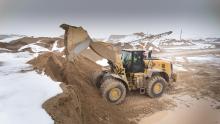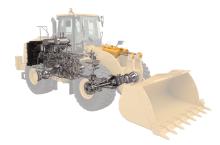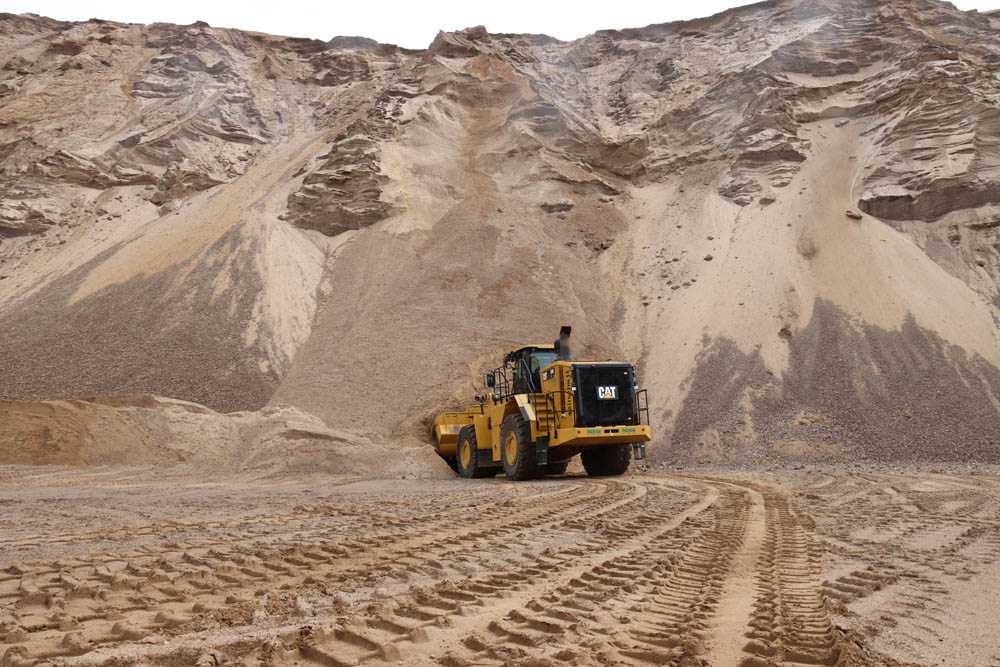
There are four big trends within the quarrying industry when it comes to aftermarket solutions, according to Herwig Peschl, Caterpillar’s aftermarket sales manager in EAME (Europe, Africa & Middle East) and Asia-Pacific.
“Since the 2008 financial crisis, what we’ve seen is reduced certainty for our customers. It has focused customers’ minds on short-term solutions. Quarries where operators focused on longer equipment fleet ownership are now looking at things that will help them mitigate the risk of owning that equipment. As part of this, there’s an emphasis on outsourcing risk: someone else owns the equipment and has the responsibility of maintaining and repairing it. This has led to more remote monitoring and assessment of the utilisation of the equipment.”
The second trend, Peschl notes, has been The Paris Agreement, a legally binding international treaty on climate change adopted by 196 parties at COP 21 in Paris, France, on 12 December 2015 and entered into force on 4 November 2016. The Agreement’s goal is to limit global warming to well below 2, preferably to 1.5° Celsius, compared to pre-industrial levels.
“The Paris Agreement’s commitment to reducing CO2 emissions has had a definite impact on our customers’ mindset. Legislation also plays into this, particularly in Europe and in some other regions, like China.
“The coronavirus pandemic has triggered strong government reactions, especially at the beginning of it. The difficulty of operating machines and getting workers onsite has meant that everything touching on machine remote control or autonomy has had an industry interest boost. Some customers ask us how we can help with this. This third trend has also led to capital expenditure being reduced quite significantly by customers. Some of them want someone else to own and maintain the machines they use rather than be personally responsible for equipment repairs and rebuilds.
“The last trend which has been happening over the last ten years is a lack of qualified technicians and machine operators. The shift in terms of environmental concerns and young people being more attracted to high-tech industries, and maybe not wanting their hands in the dirt.”
Peschl says the above four trends shape how quarrying customers are behaving and what they are asking of Caterpillar. He believes these customers weigh up a straight ‘Usership v Ownership’ choice regarding their equipment fleets.
“Our customers have noted that historically their cheapest option was purchasing a machine and owning it. Some of them are maintaining the machines themselves, others have someone else doing it, but it was pretty much an ownership model. Now customers are looking for different alternatives, such as short- or long-term rental. On top of this, some rental customers want to pay for machine usage and production capacity. This option is taking a strong foothold. There is a balance between what equipment customers wish to own and what they want to outsource, such as ensuring they have enough hauling capacity.
“We are providing capacity agreement solutions to our customers, either directly or via our dealers. As an example, a customer says they have so much capacity in their quarry, and over the next five years, they want Caterpillar to come up with the right equipment solutions to cater for it. They would then pay us a fee to assess and manage this, limiting the risk taken on by the quarries themselves. We see this happening in the UK, continental Europe, and Australia; it’s mostly in developed markets. This is not something that is off the shelf. You need to have solid conversations with the customer as you are getting into the running of a quarry. The capacity agreement option also limits any risk for the customer in terms of what happens at the end of the equipment’s working life.”
Peschl says that longer-term machine rental agreements also work well where a customer is cash-constrained, such as during the past year due to COVID-19 pandemic-induced disruption.
Another key aftermarket services area has been Caterpillar’s work with customers to reduce their fuel consumption costs. “Fuel is a third of a quarry’s mobile equipment operating cost,” explains Peter-Valentin Sauter, Caterpillar EAME market professional – Quarry Industry Solutions.

“The diesel-electric engine version of the Cat 988K XE wheeled loader, for example, uses 15,000-20,000 litres less fuel a year than the standard diesel engine model. That’s a huge cost saving to the customer. One litre of diesel generates 2.6kg of CO2. So, if you switch to using more diesel-electric machines, it will dramatically cut your operation’s carbon emissions. Many of our quarrying and cement customers, especially the larger ones, have specific CO2 goals they are trying to reach. We can provide machine solutions to help with that.
“In Germany, a CO2 tax has just been introduced on diesel. It’s adding seven or eight cents to the cost of a litre. This will scale up year on year.”
“Reducing fuel cost is something very tangible for customers,” adds Peschl. “Some of our quarrying machine models have benefitted from a huge reduction in fuel consumption in the last decade. For example, the Cat 966M XE wheeled loader has achieved an over 40% fuel consumption reduction in ten years. The ‘XE’ option on our loaders is a premium product offering the highest fuel efficiency and latest technology. These models also offer one of the lowest CO2 footprints in their industry segment.”
Helping customers finance machine fleet replacements and upgrades is another crucial area of Caterpillar’s aftermarket services’ offer.
“In developing regions, like Africa, parts of Asia and the Middle East, access to financing and machine insurance is a major worry for customers and can be a big obstacle to owning and operating equipment,” highlights Peschl. “Caterpillar can make the difference in this area because, unlike banks, we know the risk associated with equipment purchases and really know the customer looking to buy certain machines. We work in quarries, and know how quarries work. This means we are better able to serve these customers than traditional banks in these developing regions.”
Machine rebuilds are an increasingly attractive option for customers in both developed and developing parts of the world, as Peschl explains. “Rebuild is a broad term. It includes everything from component repair options and dealer-certified rebuilds up to Cat Certified Rebuilds, the latter giving customers a new-like machine. We can take, for example, a Cat 980H wheeled loader, a very common machine in the quarrying industry, and bring it up to the latest standards in terms of payload monitoring and cab.
“Rebuilds depend on what makes economic sense for the customer: is it better to do a rebuild or swap out the machine? Rebuilds have the advantage in that we can scale the degree of the rebuild, potentially keeping the machine ‘forever young’.
“We also receive requests from customers to update their Cat machines to the latest engine tier emissions standards. We’ve started to do this on certain quarrying models in India, for example. It does depend on where you start your upgrade from: it’s a different discussion if you want to upgrade your engine from Tier 2 to Tier 5 emissions standard. Each emissions tier has different engine space requirements, and an engine emissions tier upgrade needs to make economic sense for a customer. We also get requests for engine emissions tier upgrades from European customers and as part of wider machine rebuilds. We are currently evaluating our engines emissions tier upgrade service and are hoping to offer this for more quarrying machines very soon.”
Peschl says that, typically, machine rebuilds tend to make economic sense for quarrying customers when they are 50-60% of the cost of buying a new model. “We can go even lower than that if it’s a partial rebuild of a transmission or engine. There are plenty of options to choose from depending on how the customer uses each machine and how long they intend to keep it.
“When it comes to Cat rebuilds, we have the opportunity to not just provide the servicing of a machine, but the warranty on it and its financing. That is a big thing for a quarry customer keen to run their business efficiently.”
“We also have operators that don’t like to change their machines every five years,” notes Sauter. “With Cat Certified Rebuilds, they get to keep their machine, but it will work for them as a new one.”
Peschl emphasises that Cat Certified Rebuilds (CCR) are available globally via Caterpillar’s worldwide dealer network. Cat also offers Cat Certified Powertrain & Hydraulics options and Equipment Protection Plans (EPP) on various components.
Turning his attention back to the lower CO2 footprint and other sustainability gains to be had from Caterpillar’s premium quarrying machine models, Peschl continues: “With the 966M XE wheeled loader, if they are upgrading from a 966H, for example, they can yield significant CO2 footprint savings over the life of the XE model. Depending on the utilisation of the machine and its hours of work, customers can also achieve considerable CO2 footprint savings by rebuilding an M series wheeled loader. The alternative of swapping out a machine consumes CO2. Manufacturing a new 966M wheeled loader requires 25 tonnes of steel, which produces approximately 50 tonnes of CO2.”
Machine uptime is king in quarrying production, with every lost hour due to a machine needing repairs or unplanned maintenance wiping thousands off operations’ bottom lines. As such, the length of turnaround time for planned major maintenance or rebuilds is, says Peschl, a key consideration for quarry customers.
“Quarry operations tend to be keen to plan for rebuilds or major hydraulic repairs, and we can have some good conversations with customers about supplying some back-up or bridging units. This can work well, and Cat Value Agreements (CVAs) contracts in this area reassure customers. More and more customers want longer-term maintenance and repair agreements, a five, six, or anything up to a 15-year maintenance and repair agreement. Our contracts can also cover wear items, such as undercarriages. Typically these contracts allow customers to know future costs ahead of time and therefore limit uncertainty. Given quarry customer demand, we are looking to do more of the longer contracts.”
Speaking about the difference between the types of Cat aftermarket services contracts taken out by larger national or multinational quarry operators compared to small to medium-sized quarry businesses, Peschl says: “With the bigger quarries, investment decisions are not made by the local operation. There is some guidance coming from a head office with overall wider company guidelines coming into play. Smaller quarry operations are making decisions on their local needs. But they face greater risks and need to more carefully plan the timing of machine rebuilds and maintenance. We can help smaller operations in terms of our financing and flexibility around their specific needs.”
“A lack of engineer technicians is becoming a real problem,” states Sauter. “A large portion of technicians are older and retiring at a time when a lot of customers want to put machine maintenance and repairs in the hands of their machine dealers.”
To counter this, Peschl says Caterpillar and its dealers have specific engineer-technician hiring programmes and apprenticeships to ensure there is a long-term pipeline of highly trained engineer technicians to guarantee standards of work.
Sauter adds: “Given the amount of technology on the latest machines, a normal customer in-house technician will struggle to maintain these machines, placing greater emphasis on highly skilled Cat and Cat dealer technicians.”
Equipment condition monitoring and management are, says Peschl, growing areas of Caterpillar’s aftermarket services offer to quarry customers.
“There are more and more digital solutions available to help customers make more informed decisions on how they operate their equipment, how many machines they need. Often, seeing how the machines work will tell you whether you have too many or too few.
“With Cat Product Link and Cat VisionLink, we have the means to allow quarry customers to operate their fleet optimally. This is not just whether a machine has a technical issue, but productivity tools that can tell you, for example, if you have too much machine wait time in your loading area, or certain machines have too much fuel burn due to idling. This might be due to having an inexperienced operator on a key haul truck. These are examples of where quick investment decisions can be made, and rapid productivity gains had. It is an area that Peter works very closely on with our quarrying customers.”
Sauter adds: “We have more and more ‘Assist’ features on our equipment, making a low-skilled operator more efficient. This helps a quarry business a lot.”
“I’m only probably using 5% of the capabilities of my smartphone, and, likely, many operators are only using a small amount of what they could on our machines,” continues Peschl. “It has required the local operations manager or owner, if it’s a small quarry, to address this. However, that’s not their core focus; their core focus is getting production going every day. Having someone able to show you and counsel you on machine and operator performance and productivity is a key service that we and our dealers can offer.”
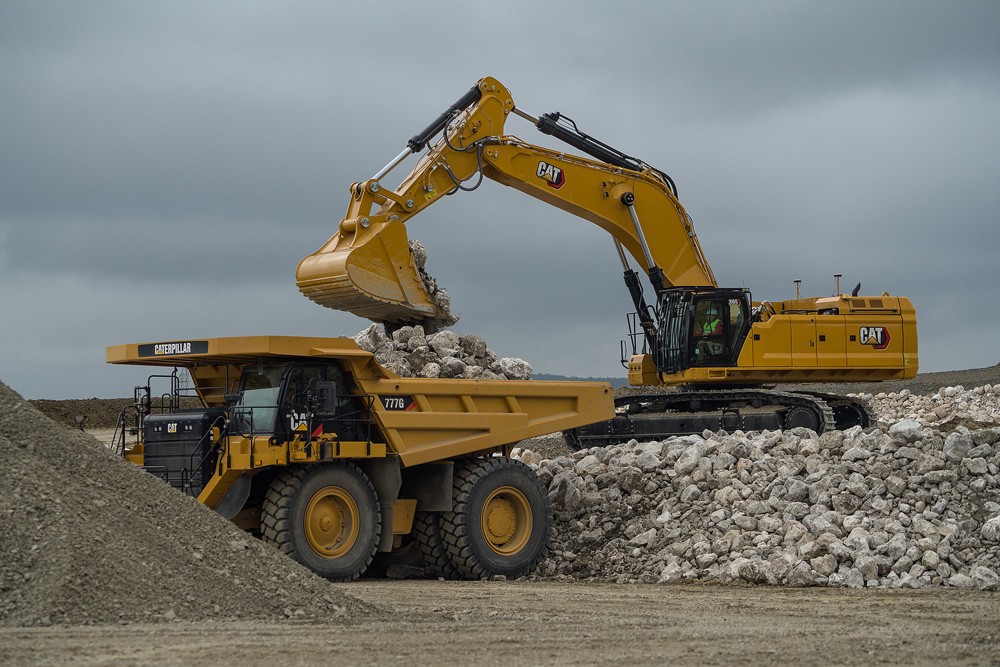
Of the current quarrying machine market take-up of Caterpillar aftermarket services contracts, Peschl says: “Of our newer machines, above 60% sold in Europe come with an aftermarket services contract. In Africa, the number is less – around 35-40%. This could be because quarry customers in the region might be less familiar with services contracts. However, we’re north of 50% for service contracts in most regions.”
Launched in late 2018, Cat Remote Troubleshoot and Cat Remote Flash are two examples of how Cat Remote Services are leveraging telematics data to enable diagnostic checks and software upgrades to be performed by dealers without being physically near quarrying machines.
Available with a range of newer Cat quarrying-suited models, such as the January 2021-launched next-generation large excavators (352, 374 and 395), the L and M series wheeled loaders (950M to 972 XE), and the May 2021-unveiled 980, 980 XE, 982, and 982 XE wheeled loaders, Remote Troubleshoot analyses real-time asset data, so the dealer can run diagnostics testing on the connected machine and pinpoint possible issues, saving on travel time as well as downtime of the vehicle during the test.
In addition to diagnosing remotely, the dealer can, in certain instances, resolve the situation there and then or, if necessary, technicians can be dispatched with the appropriate tools and parts to fix the machine.
Remote Flash ensures equipment operates with the most up-to-date version of onboard software, with remote updates to the software of a connected machine or engine, at a convenient time to the operation. This negates the need for a service technician to visit the quarry site.
“Time-wise, for every [Remote Flash] software update, it probably saves around two hours of machine downtime. That’s quite significant,” says Peschl. “Also, if a technician needs to come out and troubleshoot a machine problem, that could take a few hours for them to travel to the quarry site. The customer would need to pay for that. If a dealer uses Remote Troubleshoot to conduct a ‘machine status report’, and a technician still needs to come out, then when they arrive on-site, they will have access to the right replacement part or parts to solve a problem.”
Peschl says the COVID-19 pandemic has heightened customer interest in remote control and autonomous machines. “At CONEXPO/CON-AGG last year, we launched our Cat Command ‘Remote Control Station’ for construction machine operators. Operators are working remotely from an office using multiple cameras set up on the on-site machine. They are not sitting in a moving machine and are less tired at the end of the day.”
Peschl says that more emphasis is now placed on how a quarry is set up to make the possibility of introducing the ‘Remote Control Station’ technology in that environment more feasible.
But what about the introduction of Caterpillar autonomous machines in quarries? “It’s something we are working on. We have already had autonomous machines working in mines for many years. Our customers have gone more than 50 million kilometres without an incident, and in some mines, like in Australia, we have machines running 24/7. The investment level required for a quarry to have that does not currently pay off, partly because a quarry’s operating layout and needs can change every day. We are working on a more affordable, semi-autonomous solution. This could assist the operator in, for instance, the material loading and dumping cycles.”
Peschl says it’s feasible to think that when more skilled engineering technician support and other infrastructure is in place, and site layout and other operating issues addressed, the first quarries featuring autonomous machines could be processing aggregates material in “five to six years”.
“If you don’t have efficient operating processes now, there is no way they become efficient through machine automation,” stresses Sauter. “Automation will address inefficiencies caused by the operator, such as average operator practices, loading techniques, overspeeding etc. It will not, however, address inefficiencies caused by a wrong site set-up. This could include poor haul road design, an excavator doing same-level loading instead of bench loading. Automation will also not address a wrong fleet match or wrong equipment selection.
“Continuous material flow throughout the quarry process chain is critical for efficient quarry operation. Continuous material flow means that the hourly capacity of the crusher – the bottle neck of an operation – needs to be in sync with hourly production capability of the loading fleet and the hauling fleet. If there is a mismatch between loading, hauling and crusher capacities, inefficiencies will get created. Idling time at the crusher or in the loading area would be a result of a mismatch, leading to the underutilisation of a hauling and loading machines.”
“I’ve noticed there’s a lot of talk, including among some of our quarrying customers, about street truck-sized autonomous solutions for quarries. But that’s not what we’re looking at,” explains Peschl. “There’s also a lot of autonomous-machine hype that’s been coming from the automotive industry that is just not applicable to quarrying.”
Quarry operators don’t go in for hype. A traditionally conservative industry needs to be convinced that spending hard-earned money on new technology and services is worthwhile. After an hour’s conversation with Aggregates Business, Caterpillar’s Herwig Peschl and Peter-Valentin Sauter have laid out a persuasive argument for investing in equipment aftermarket services. We look forward to seeing what the American off-highway equipment giant does next in this increasingly important area of the quarrying sector.
Otterbein Cat 772F Truck rebuild
Zement & Kalkwerke Otterbein (Otterbein) is a fifth-generation family company located in Großenlüder-Müs, north-east of Frankfurt in Germany. It was established in 1889 by Georg Otterbein, who laid the foundation for today’s company to merge small limestone work operations.
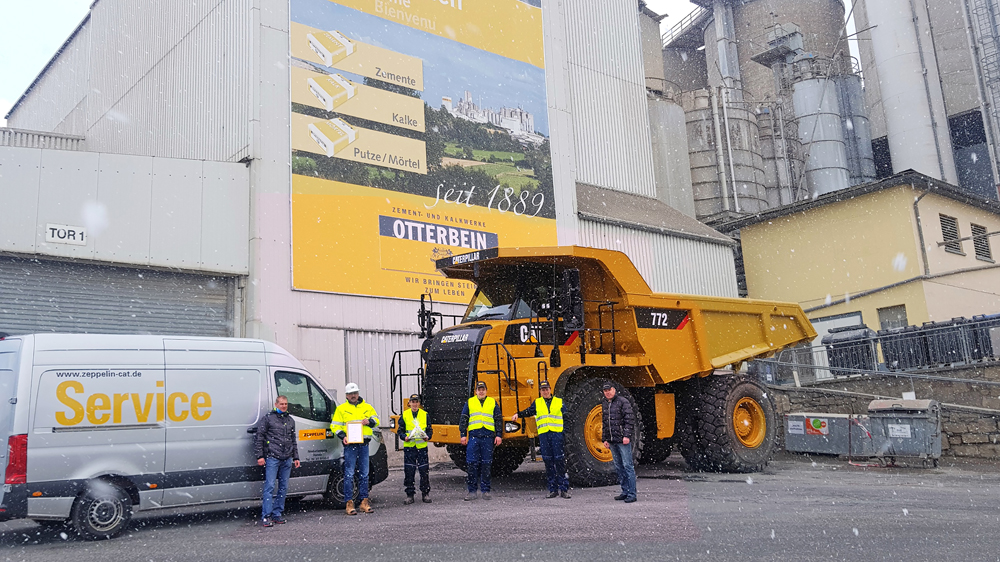
Otterbein extracts limestone to produce a comprehensive and high-quality range of over 100 cement, lime, plaster, and mortar products, as well as mineral paints. Those products are used in civil engineering and road construction works, housing construction, monument preservation, agriculture, forestry, and pond management. Some products are also used in industrial environmental protection, for example, drinking water treatment and air pollution control.
Otterbein had been using a Cat 772F dump truck since 2008, which had clocked 14,526 hours in 12 years carrying 50 tonnes of shell limestone 1,200 metres between the loading point and the stationary crusher. In 2019, Otterbein commissioned Zeppelin to carry out a Cat Certified Rebuild overhaul of its 772F truck. The work, carried out at the Zeppelin Hanau branch from December 2020 to March 2021, involved a complete overhaul of the machine, including a new Cat engine, torque converter, transmission, axles, and hydraulics. Parts that do not meet the strict Caterpillar reusability guidelines were replaced. This represented approximately 7,000 parts, including hoses, drive belts, sealing rings, seals, bearings, operating heads, cables, switches, and instruments.
“One of our requirements was to reduce the noise level from the exhaust system and heater. Noise reduction is one area we continually focus on in the interest of the residents who live in proximity to the quarry,” says Bernhard Pfohl, Otterbein’s quarry operations manager.
He adds: “Our limestone is very soft, so the vehicle frame was not damaged. For that reason alone, it would have been a waste not to continue using the truck. Through rebuilding, we contribute to more sustainability.”
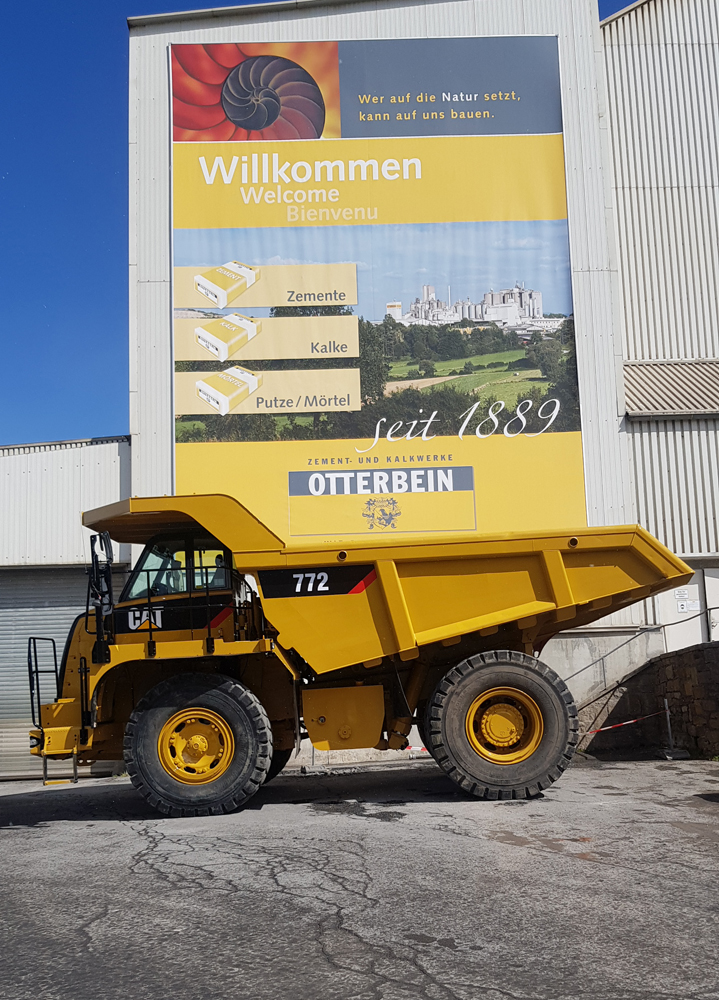
Before the Cat 772F truck went back to full operation at the quarry, Zeppelin carried out more than 350 tests and inspections, including throttle response, stall speed rpm, brake speed, transmission and steering clutch response, and hydraulic and pilot pressure relief valve tests.
As the result of the rebuild, the Cat 772F starts its second service life with a new rebuild identification number. “With our experience of having a unit rebuilt with Zeppelin and because of the cost advantage compared to buying a new truck, we opted for another rebuild,” Pfohl explains.
“With the new machine warranty and a full-service contract, not only are we well covered, but we also know what the costs are. [Zeppelin Hanau] Service manager Dominik Leber and service advisor Bernhard Hohmann gave us professional advice and dealt with our questions thoroughly.”
Pfohl says he now expects the same near 14,000 operating hours from the rebuilt Cat 772F truck that he got with the original truck.

